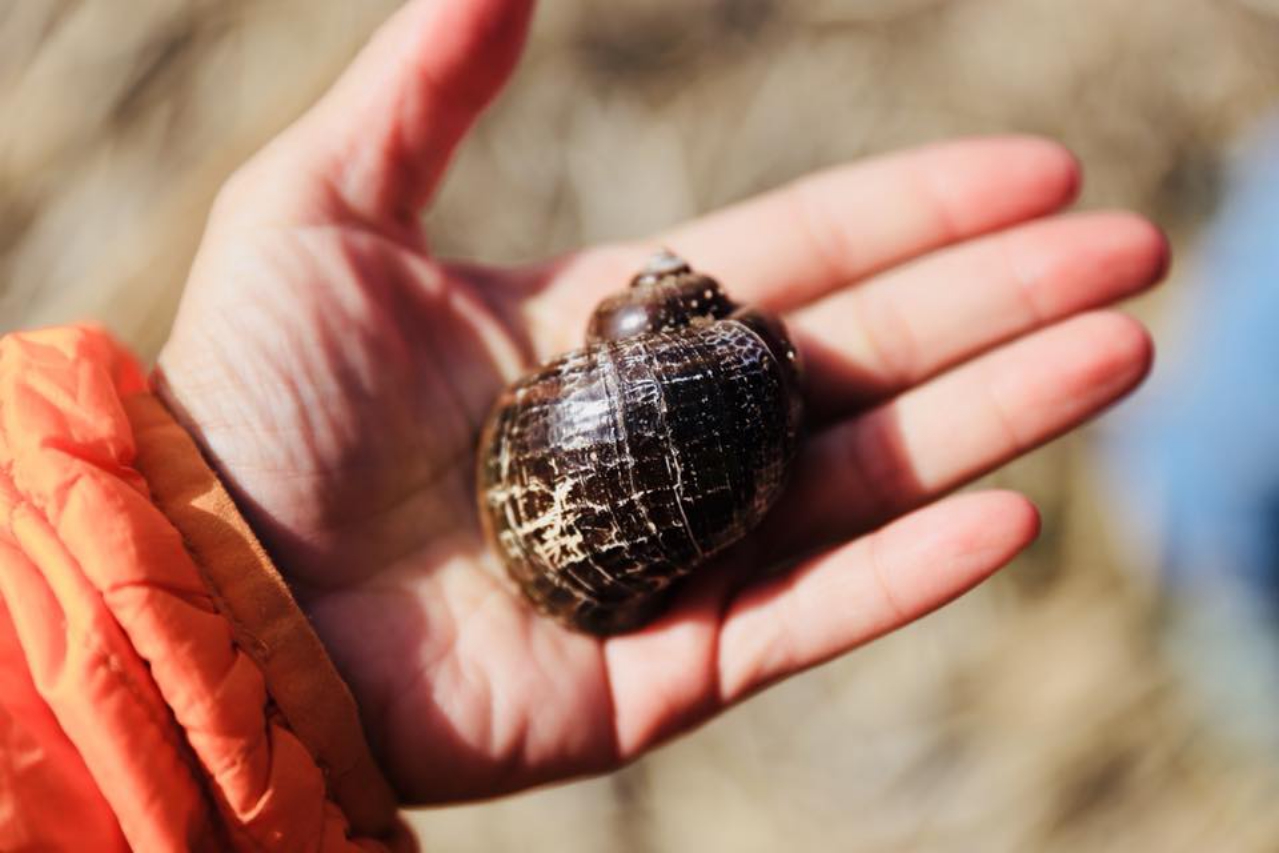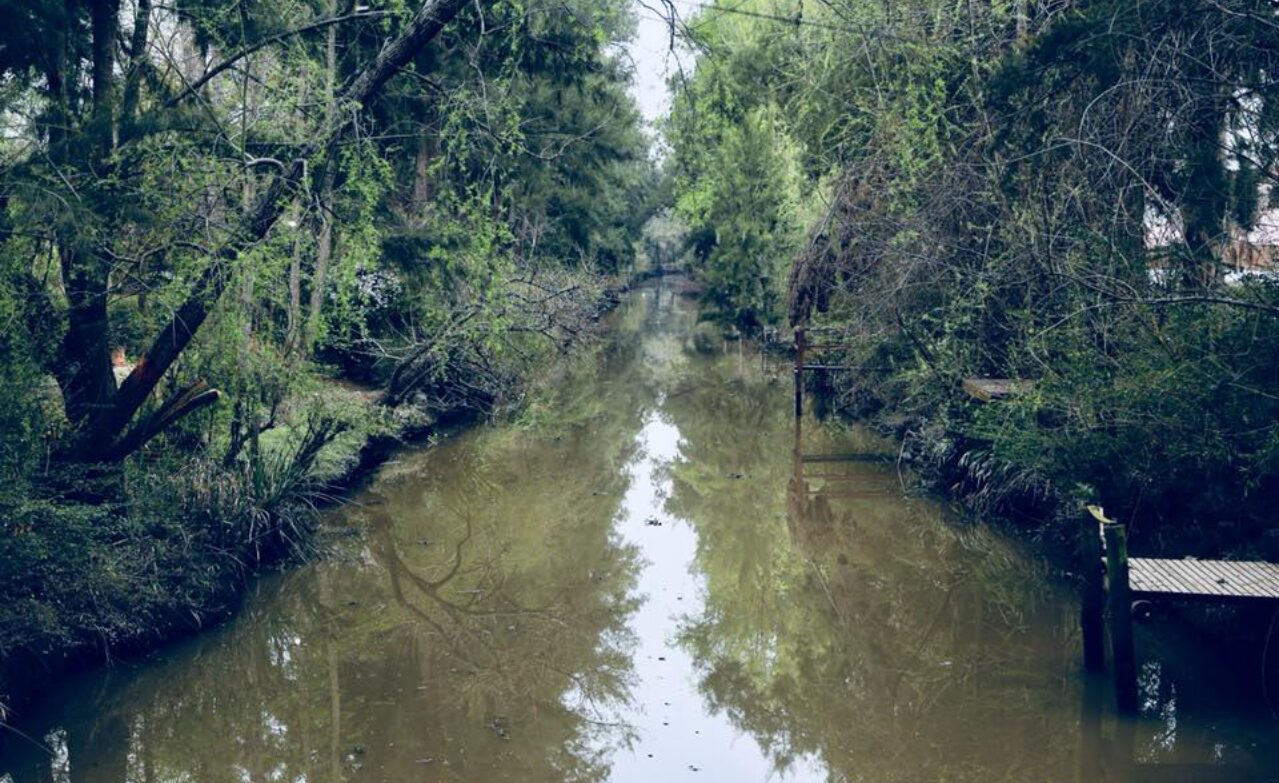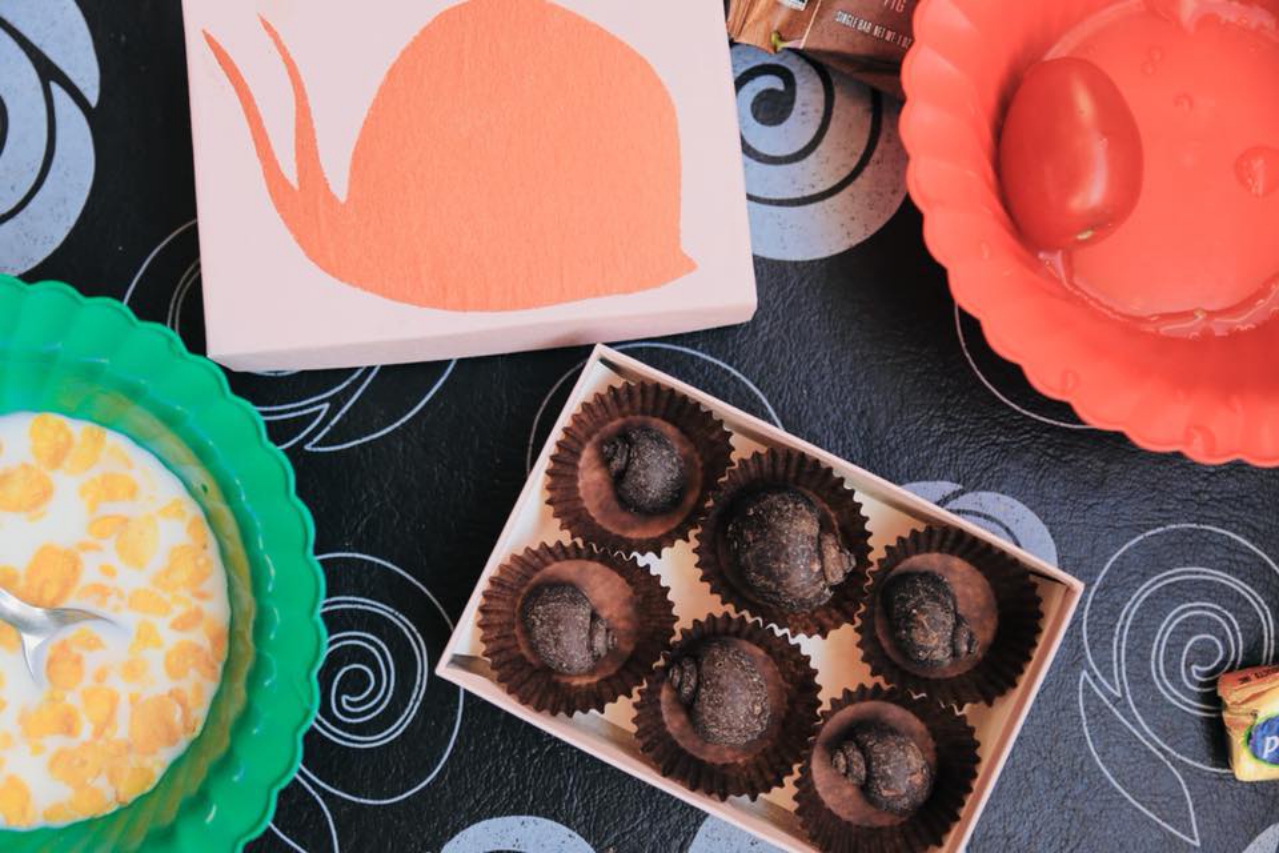站在阿根廷一處偏遠荒涼的潟湖旁,水波啪啪啪地打在岸上,風冷得要命,我們埋頭找東西,甚至踏入冰冷的湖水中搜尋。
在來到這座潟湖前,我們經歷了一段漫長的旅程。從宜蘭到桃園機場後,先飛菲律賓,候機8小時,轉搭12小時的長途飛機跨越太平洋,到洛杉磯住一夜,隔日再搭乘一班跨越美洲的班機,飛12小時,降落在阿根廷的布宜諾斯艾利斯。一刻也不停留地包車前往國內線機場,再飛一個小時,終於來到了布蘭卡港(Bahía Blanca)。從布蘭卡港的市區,開車要來到這座潟湖(Laguna Las Encadenadas),還要開車100公里。千里迢迢,跨過換日線,來到地球的另一端,一個季節與日夜都與臺灣顛倒的地方,只是為了找尋福壽螺(Pomacea canaliculata)。
而我們來的地方對福壽螺有其特殊的意義,阿根廷是臺灣福壽螺的故鄉,布蘭卡港有研究專門福壽螺的學者,而這座潟湖的位置則接近福壽螺在阿根廷分布的南界。
我們組成的「追螺團」一行共四個人:晏霖是人類學學者,是土拉客實驗農家園的成員;芳儀是生態學家,主持農田裡的科學計畫,而我是藝術家的身分,平常是經營田文社粉絲專頁;另外還有一位助理崔崔。我們幾人共同的地方,是都在宜蘭從事友善耕作的水稻種植。
福壽螺是水稻的頭號害蟲,多年來我們因為種植水稻,與福壽螺近身交手,飽受摧殘,福壽螺讓我們恨得無奈,但為了解決福壽螺的問題,越來越了解這個親愛的敵人,最終由恨生愛,被福壽螺吸引,投入了福壽螺的尋根之旅,也因此組成了這次的南美洲追螺團。
我們懷抱著幾個問題來到阿根廷,一個是福壽螺是在什麼樣的狀況下從阿根廷歷經這麼長的旅途被帶到臺灣。另一件事,是福壽螺在牠們的原產地生活的樣貌。牠們對當地的作物或環境有造成危害嗎?牠們在當地的天敵是什麼樣子的呢?為什麼到了臺灣、到了亞洲,變得這麼勢不可擋?因為這一連串的疑惑,我們決定要去拜訪阿根廷研究福壽螺的學者,觀察他們的稻作環境,還要沿著螺的生活水域去找螺。
而現在,光是站在吹著寒風的Encadenadas潟湖旁,我們心中的疑問就被解釋了一大半。
在這邊福壽螺根本就沒機會。
 阿根廷的福壽螺因為生存環境,表面都帶有滄桑感的螺殼。圖/Over攝影
阿根廷的福壽螺因為生存環境,表面都帶有滄桑感的螺殼。圖/Over攝影
在這個福壽螺分佈的南界,相對大約是韓國的緯度,零下的低溫,讓大部分的螺都撐不過冬天,族群量因而被氣候抑制。我們撿到的螺殼上都充滿刮痕,看起來歷經滄桑。甚至在8月,南美洲冬天的尾巴,我們連一顆活的螺都找不到。隨著旅程的推進,從布宜諾斯艾利斯開車沿著巴拉那河(Paraná River)北上,氣候越來越溫暖,這一段路大致上也是文獻資料中查到的福壽螺主要生活區域。在離布宜諾斯艾利斯開車約7小時路程的聖塔菲省(Santa Fe),我們歷經了此生最壯闊的巡田水。聖塔菲省是阿根廷主要的稻米產區,兩位蛙類研究的學者與農場工作人員、開車帶著我們繞行農場一周。從入口開到底的直線距離是20公里,農場的尺幅超過我們的想像,廣達一萬公頃。這是一趟宛若薩伐旅(safari)1的行程,在灌溉水道中有鱷魚、路邊有巨蛇、途中觀測記錄到多種鳥類,其中最重要的,就是以福壽螺為主要飲食來源的螺鷹(snail kite),以及秧鶴(limpkin)。
沿路有一些當作圍欄打在地上的木樁,下面有一堆一堆的螺塚,那都是螺鷹挖取福壽螺的肉之後拋下的螺殼。這讓我們意識到一件事情,福壽螺在牠的原生地,是非常重要的食物鏈基礎,許多生物都以牠為食,包括浣熊、蛇、鱷魚、秧鶴、螺鷹,不同程度上都仰賴福壽螺維生。反而是若沒有了福壽螺,將會造成生態上的大問題。
 左:筆記本裡的螺鷹與秧鶴。右:木樁下的螺塚,是螺鷹吃完的福壽螺殼。圖/Over攝影
左:筆記本裡的螺鷹與秧鶴。右:木樁下的螺塚,是螺鷹吃完的福壽螺殼。圖/Over攝影
很多資料都說在臺灣福壽螺沒有天敵,但其實芳儀與一些紀錄都觀察並記載到:許多臺灣的生物,像是紅冠水雞、白腹秧雞、彩鷸、柴棺龜已經學會吃福壽螺。問題是當農田生態被破壞,食物鏈斷掉,就會形成一個生態上的真空狀態,如同「歡迎福壽螺吃到飽」,然後卻衍生造成後端生物數量失控的狀態。
在耕種方式也有所不同,這裡採用的是乾式直播2,用機器把土劃開、播種、覆土。等到秧苗長大把水放進來的時候,福壽螺早已啃不動了。相較之下,臺灣的水田操作,福壽螺在臺灣根本是來到了天堂,一個讓他們多子多孫的繁殖勝地。
人為的農耕操作與食物鏈影響了福壽螺的生態,而在歷史上,福壽螺的歷史更是一段人與生物不斷糾葛的過程。福壽螺大約在50年前被引進臺灣,目前網路上的文字敘述,大抵稱是由「某人」從阿根廷引進,想要發展養殖並且打入食用螺肉的市場。後來因為口感不佳,福壽螺被丟棄以至於擴散的單線故事。
大多的敘述,就停留在此處,並且批評當時的引進者行為是荒唐、夭壽的個人行為。跟隨著晏霖以人類學田野的方式追尋,以及在臺灣、阿根廷兩地的查訪,卻可以慢慢顯現出這個故事的立體之處。當時的臺灣人不是無緣無故地來到阿根廷。彼時的臺灣剛被退出聯合國,政局不穩,因此有一批臺灣的投資移民,受到當時未經二戰摧殘,高度發展、地大物博的阿根廷吸引,來到這裡闖蕩。
來到阿根廷之後,有的購置農場、種洋菇、蔬菜、豆芽菜等,更多的是開超市、餐館,在異地摸索各種創業的方法。在這個什麼都可能是生意,但什麼也都可能失敗的狀況下,有人在離布宜諾斯艾利斯大約一小時車程的河裡釣魚,注意到福壽螺,便起意讓要回臺的親友帶幾顆回去養養看。值得注意的是當時在臺灣,養螺並不是一項新興產業,之前就有人從非洲帶元寶螺回來試著養殖。生態保育的意識也還沒像現在普遍,福壽螺更像一件商品或食品。
 聖塔菲省(Santa Fe)河域,接近當年捕撈福壽螺的地點。圖/Over攝影
聖塔菲省(Santa Fe)河域,接近當年捕撈福壽螺的地點。圖/Over攝影
至於福壽螺的養殖為何在臺灣快速擴散,晏霖說要追溯到70年代的高雄美濃,在一個產業的轉換點上,農業收入水準不斷降低,重稅綁在田上,農產收入又少,農村開始衰敗,又因為美援的穀物進口,台糖開始規模化養豬,讓農家本來當副業的養豬價格受到衝擊。原本的農業社會不得以開始尋覓其他出路,往工商社會邁進,福壽螺便是在這個時間點成為一個受歡迎的副業之一。
當終於有人試吃,並發現福壽螺的口感不如預期,並且意識到,福壽螺會吃掉水稻等經濟作物時,這件事已經變成一個不能說的事實了。福壽螺從一個聚落交易到另一個聚落,等到福壽螺的名聲終於崩盤,被從排水溝偷偷流放出去,加上臺灣水利溝渠密佈,到了颱風水患季節又淹水,福壽螺更是移動自如,來去無阻。
因數量大,加上當時的農田已開始使用農藥,物種生態已經不是這麼健全,宛若形成一個真空狀態、一個超級博愛座,讓福壽螺來到與阿根廷家鄉截然不同的天堂。顯然這已經不是剛開始的那幾顆來臺螺祖能預見的開支繁盛。第一個起意的人,一直在阿根廷,根本沒有經手過福壽螺事業。
我們也意識到,這是一段對相關人士都不容易敘述的黑歷史,該如何開啟對話,並回憶起那些未經竄改、掩蓋過的記憶,於是,我準備了幾組巧克力禮盒。
造型是擬真的黑巧克力福壽螺,以及粉紅色的巧克力福壽螺卵。那是我們為了模擬了幾種當年福壽螺可能來臺的方式:偽裝成金沙巧克力、包裹在內衣褲中、裝在不透明的罐子中等方式中的其中一種。
 特製的福壽螺巧克力。圖/Over攝影
特製的福壽螺巧克力。圖/Over攝影
 與福壽螺學者在潟湖旁喝瑪黛茶交流。圖/Over攝影
與福壽螺學者在潟湖旁喝瑪黛茶交流。圖/Over攝影
這是一趟帶福壽螺回娘家的旅程,50年前來到臺灣的福壽螺,雖非自願,但早已開枝散葉、落地生根。半世紀後,我們回溯福壽螺來臺的那一段漫漫長路,雖然無法帶上福壽螺本人,但準備了福壽螺形體的巧克力,以及田文社販售的福壽螺卵貼紙、福壽螺手拭巾等產品。
當我們在與當地學者、移民的交流中把禮物送上,並解釋我們對福壽螺的觀點,說明福壽螺已經不是一個無法解決的問題,有殺螺藥,也有各種生態減螺的方法正在發展,最終我們還利用了福壽螺的哏,讓很多人對農田生態有更深的了解,受訪者也如釋重負般地啞然失笑。
這一趟福壽螺回娘家的旅程雖然告一段落,但人螺交手之路方興未艾,這幾年我們早已意識到福壽螺不可能完全從臺灣的生態系中消失,芳儀經常提到,研究在生態與農法上如何與福壽螺共生,才長久之計。
旅程接近尾聲時,我們終於來到福壽螺當初被收集撿拾,並且引渡回臺灣的那一個現場,只是風景已經跟當年宛若異地。50年的時光,一個物種來到地球最遙遠的另一端,而我們又因此來到這個地方,各有不同領域背景的螺團團員一起站在這邊,還有當初的關係人、移民、阿根廷學者,串連起跨越太平洋,幾乎處於對蹠點的阿根廷與臺灣,也讓我們跨越了人與螺的生物界線,共同敘述出一段人螺交織的歷史。